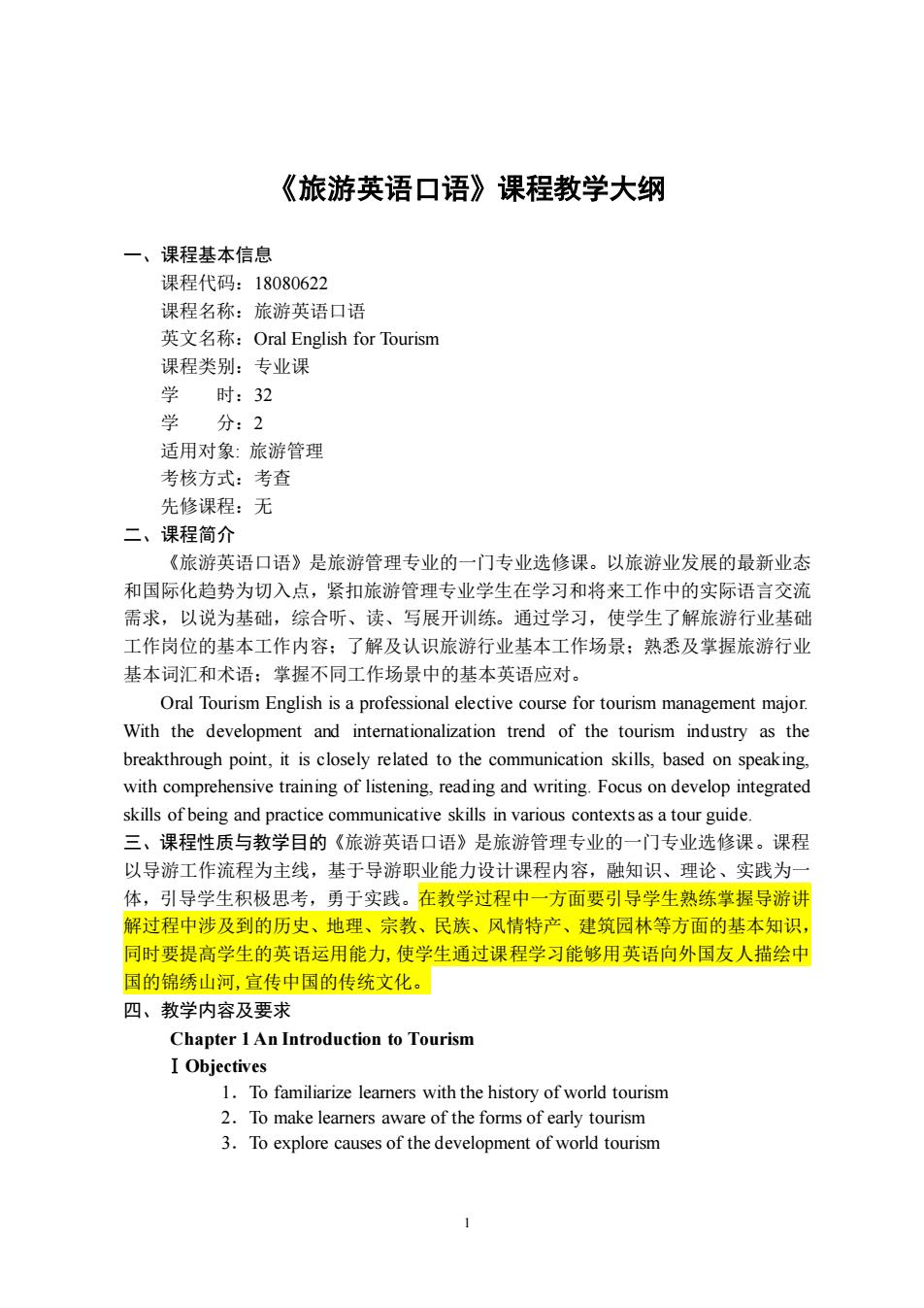
《旅游英语口语》课程教学大纲 一、课程基本信息 课程代码:18080622 课程名称:旅游英语口语 英文名称:Oral English for Tourism 课程类别:专业课 学 时:32 学分:2 适用对象:旅游管理 考核方式:考查 先修课程:无 二、课程简介 《旅游英语口语》是旅游管理专业的一门专业选修课。以旅游业发展的最新业态 和国际化趋势为切入点,紧扣旅游管理专业学生在学习和将来工作中的实际语言交流 需求,以说为基础,综合听、读、写展开训练。通过学习,使学生了解旅游行业基础 工作岗位的基本工作内容:了解及认识旅游行业基本工作场景:熟悉及掌握旅游行业 基本词汇和术语:掌握不同工作场景中的基本英语应对。 Oral Tourism English is a professional elective course for tourism management major. With the development and internationalization trend of the tourism industry as the breakthrough point,it is closely related to the communication skills,based on speaking with comprehensive training of listening,reading and writing.Focus on develop integrated skils of being and practice communicative skills in various contextsas a tour guide. 三、课程性质与教学目的《旅游英语口语》是旅游管理专业的一门专业选修课。课程 以导游工作流程为主线,基于导游职业能力设计课程内容,融知识、理论、实践为 体,引导学生积极思考,勇于实践。在教学过程中一方面要引导学生熟练掌握导游讲 解过程中涉及到的历史、地理、宗教、民族、风情特产、建筑园林等方面的基本知识 同时要提高学生的英语运用能力,使学生通过课程学习能够用英语向外国友人描绘中 国的锦绣山河,宜传中国的传统文化。 四、教学内容及要求 Chapter 1 An Introduction to Tourism I Objectives 1.To familiarize leamers with the history of world tourism 2.To make learners aware of the forms of early tourism 3.To explore causes of the development of world tourism 1
1 《旅游英语口语》课程教学大纲 一、课程基本信息 课程代码:18080622 课程名称:旅游英语口语 英文名称:Oral English for Tourism 课程类别:专业课 学 时:32 学 分:2 适用对象: 旅游管理 考核方式:考查 先修课程:无 二、课程简介 《旅游英语口语》是旅游管理专业的一门专业选修课。以旅游业发展的最新业态 和国际化趋势为切入点,紧扣旅游管理专业学生在学习和将来工作中的实际语言交流 需求,以说为基础,综合听、读、写展开训练。通过学习,使学生了解旅游行业基础 工作岗位的基本工作内容;了解及认识旅游行业基本工作场景;熟悉及掌握旅游行业 基本词汇和术语;掌握不同工作场景中的基本英语应对。 Oral Tourism English is a professional elective course for tourism management major. With the development and internationalization trend of the tourism industry as the breakthrough point, it is closely related to the communication skills, based on speaking, with comprehensive training of listening, reading and writing. Focus on develop integrated skills of being and practice communicative skills in various contexts as a tour guide. 三、课程性质与教学目的《旅游英语口语》是旅游管理专业的一门专业选修课。课程 以导游工作流程为主线,基于导游职业能力设计课程内容,融知识、理论、实践为一 体,引导学生积极思考,勇于实践。在教学过程中一方面要引导学生熟练掌握导游讲 解过程中涉及到的历史、地理、宗教、民族、风情特产、建筑园林等方面的基本知识, 同时要提高学生的英语运用能力,使学生通过课程学习能够用英语向外国友人描绘中 国的锦绣山河,宣传中国的传统文化。 四、教学内容及要求 Chapter 1 An Introduction to Tourism ⅠObjectives 1.To familiarize learners with the history of world tourism 2.To make learners aware of the forms of early tourism 3.To explore causes of the development of world tourism
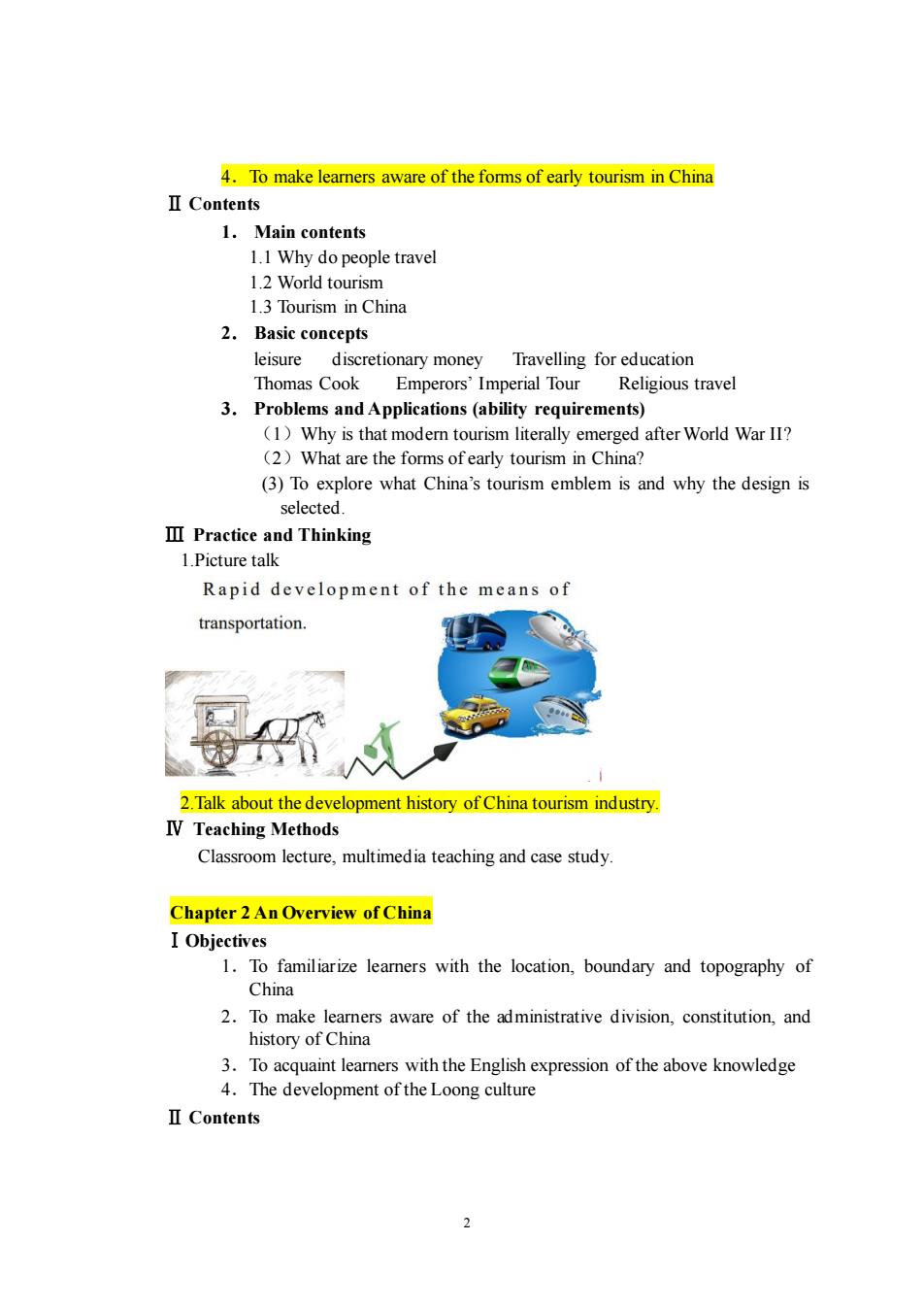
4.To make learners aware of the forms of early tourism in China II Contents 1.Main contents 1.1 Why do people travel 1 2 World tourism 1.3 Tourism in Chin 2.Basic concepts leisure discretionary money Travelling for education Thomas Cook Emperors'Imperial Tou Religious travel 3.Problems and Applications(ability requirements) (1)Why is that modern tourism literally emerged after World War II? (2)What are the forms ofearly tourism in China? (3)To explore what China's tourism emblem is and why the design is selected II Practice and Thinking 1.Picture talk Rapid development of the means of transportation. 4☑元 2.Talk about the development history of China tourism industry. IV Teaching Methods Classroom lecture,multimedia teaching and case study. Chapter 2 An Overview of China I Objectives 1.To familiarize leamners with the location,boundary and topography of China 2.To make lea ners aware of the administrative division,constitution,and history of China 3.To acquaint learners with the English expression of the above knowledge 4.The development of the Loong culture II Contents 2
2 4.To make learners aware of the forms of early tourism in China Ⅱ Contents 1. Main contents 1.1 Why do people travel 1.2 World tourism 1.3 Tourism in China 2. Basic concepts leisure discretionary money Travelling for education Thomas Cook Emperors’ Imperial Tour Religious travel 3. Problems and Applications (ability requirements) (1)Why is that modern tourism literally emerged after World War II? (2)What are the forms of early tourism in China? (3) To explore what China’s tourism emblem is and why the design is selected. Ⅲ Practice and Thinking 1.Picture talk 2.Talk about the development history of China tourism industry. Ⅳ Teaching Methods Classroom lecture, multimedia teaching and case study. Chapter 2 An Overview of China ⅠObjectives 1.To familiarize learners with the location, boundary and topography of China 2.To make learners aware of the administrative division, constitution, and history of China 3.To acquaint learners with the English expression of the above knowledge 4.The development of the Loong culture Ⅱ Contents
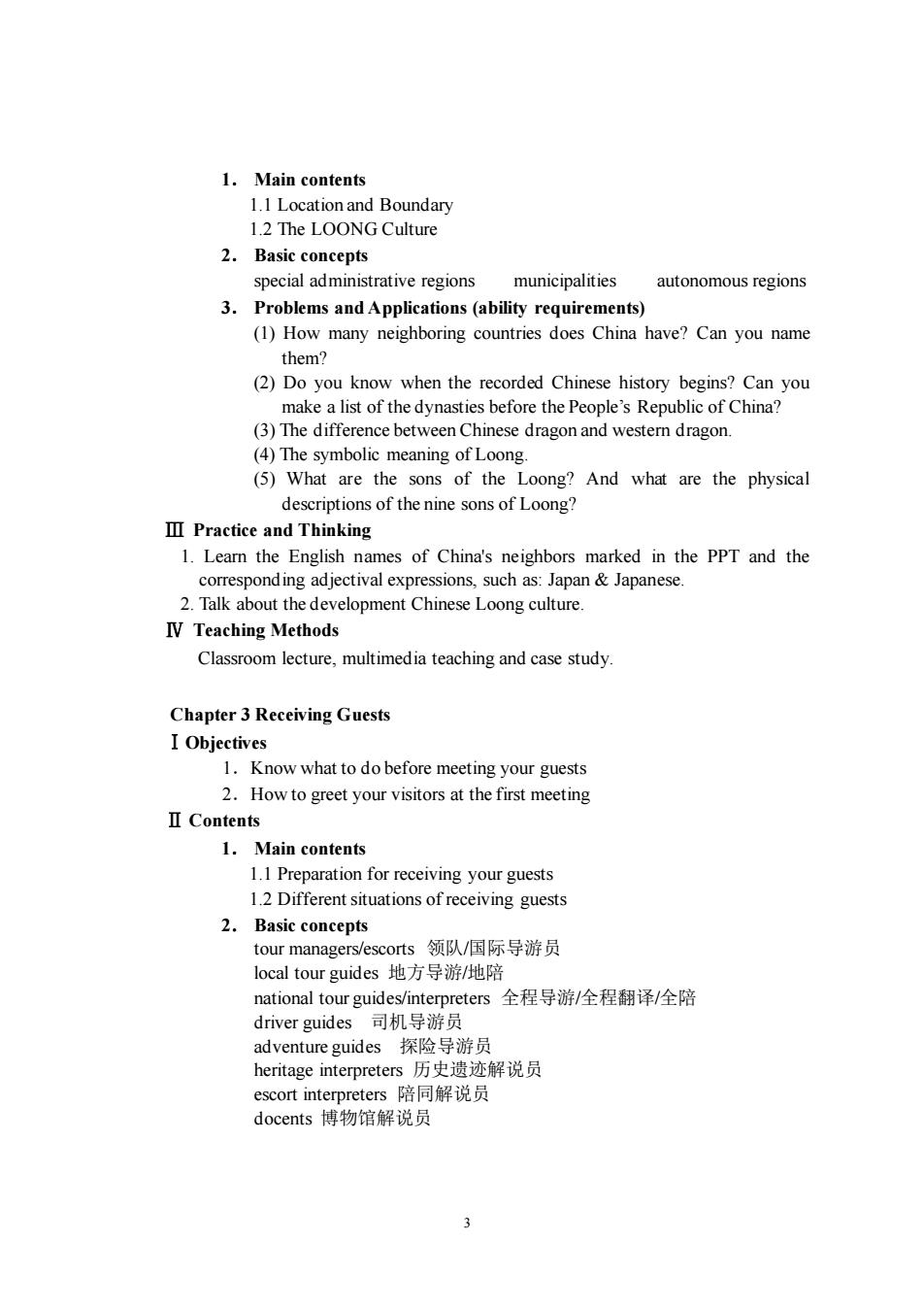
1.Main contents 1.1Locationand Boundary 1.2 The LOONG Culture 2.Basic concepts special administrative regions municipalities autonomous regions 3.Problems and Applications(ability requirements) (1)How many neighboring countries does China have?Can you name them? (2)Do you know when the recorded Chinese history begins?Can you make a list of the dynasties before the People's Republic of China (3)The difference between Chinese dragon and western dragon. (4)The symbolic meaning of Loong. (5)What are the sons of the Loong?And what are the physical descriptions of the nine sons of Loong? II Practice and Thinking 1.Leamn the English names of China's neighbors marked in the PPT and the corresponding adjectival expressions,such as:Japan Japanese. 2.Talk the de velopme nt Ch inese Loong culture IV Teaching Methods Classroom lecture,multimedia teaching and case study Chapter 3 Receiving Guests I Objectives 1.Know what to do before meeting your guests 2.How to greet your visitors at the first meeting II Contents 1.Main contents 1.I Preparation for receiving your guests 1.2 Different situations of receiving guests 2.Basic concepts tour managers 领队国际导游员 local tour guides地方导游/地陪 national tour guides//interpreters全程导游/全程翻译/全陪 driver guides司机导游员 ure guides探险导游员 tes历史遗迹解说员 escort interpre 解说员 docents博物馆解说员 3
3 1. Main contents 1.1 Location and Boundary 1.2 The LOONG Culture 2. Basic concepts special administrative regions municipalities autonomous regions 3. Problems and Applications (ability requirements) (1) How many neighboring countries does China have? Can you name them? (2) Do you know when the recorded Chinese history begins? Can you make a list of the dynasties before the People’s Republic of China? (3) The difference between Chinese dragon and western dragon. (4) The symbolic meaning of Loong. (5) What are the sons of the Loong? And what are the physical descriptions of the nine sons of Loong? Ⅲ Practice and Thinking 1. Learn the English names of China's neighbors marked in the PPT and the corresponding adjectival expressions, such as: Japan & Japanese. 2. Talk about the development Chinese Loong culture. Ⅳ Teaching Methods Classroom lecture, multimedia teaching and case study. Chapter 3 Receiving Guests ⅠObjectives 1.Know what to do before meeting your guests 2.How to greet your visitors at the first meeting Ⅱ Contents 1. Main contents 1.1 Preparation for receiving your guests 1.2 Different situations of receiving guests 2. Basic concepts tour managers/escorts 领队/国际导游员 local tour guides 地方导游/地陪 national tour guides/interpreters 全程导游/全程翻译/全陪 driver guides 司机导游员 adventure guides 探险导游员 heritage interpreters 历史遗迹解说员 escort interpreters 陪同解说员 docents 博物馆解说员
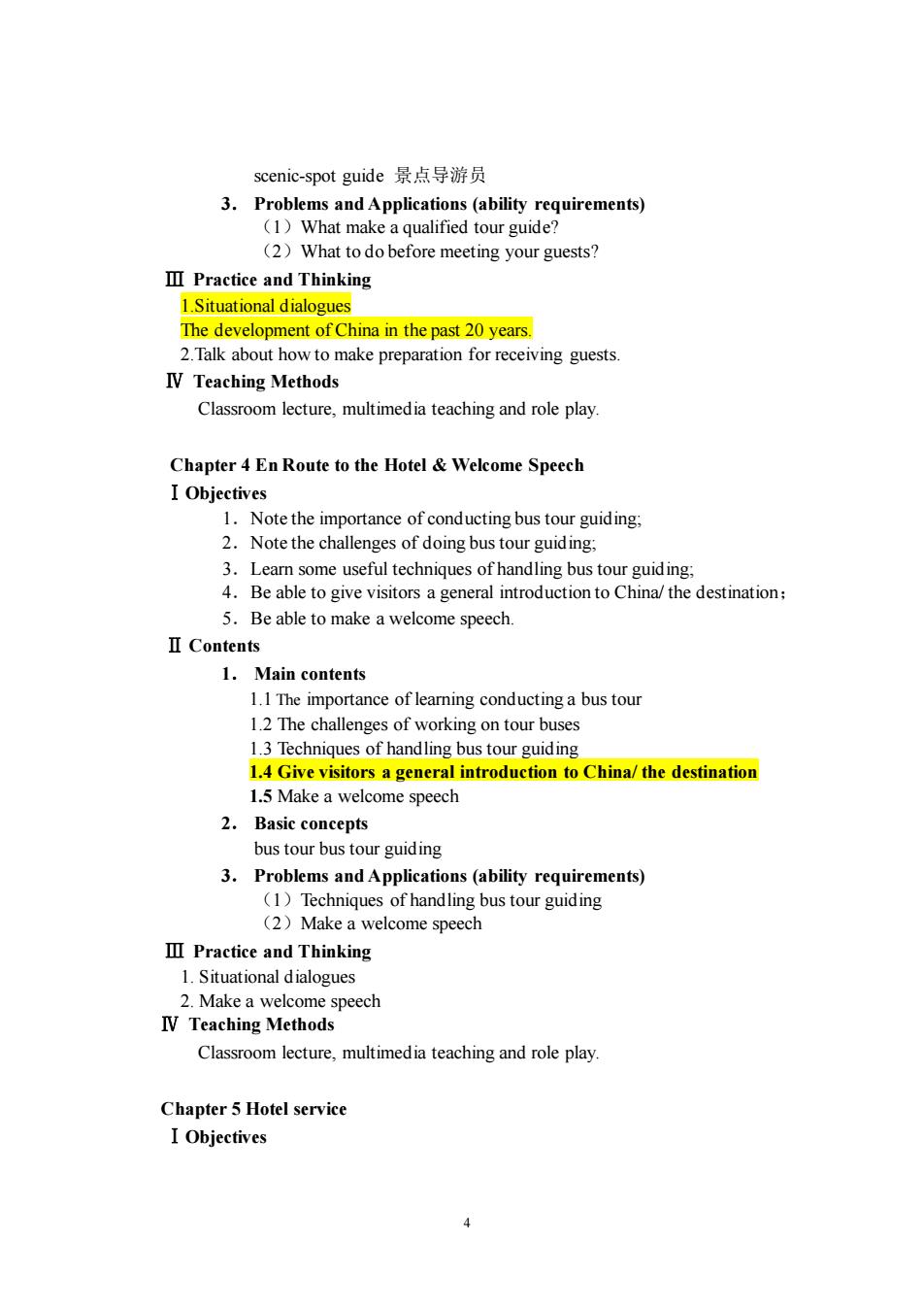
scenic-spot guide景点导游员 3.Problems and Applications(ability requirements) (1)What (2)What to do II Practice and Thinking The development of China in the past 20 years. 2.Talk about how to make preparation for receiving guests IV Teaching Methods Classroom lecture.multimedia teaching and role play Chapter 4 En Route to the Hotel Welcome Speech I Objectives Note the importance of conducting bus tour guiding. 2.Note the challenges of doing bus tour guiding; 3.Leam some useful techniques of handling bus tour guiding 4.Be able to give visitors a general introduction to China/the destination 5.Be able to make a welcome speech ⅡContents 1.Main contents 1.1 The importance of learning conducting a bus tour 1.2 The challenges of working on tour buses 1.3 Techniques of handling b id ir 1.4Gi rs a general introduction to China/the destination 1.5 Make a welcome speech 2.Basic concepts bus tour bus tour guiding 3.Problems and Applications(ability requirements) (1)Techniques of handling bus tour guiding (2)Make a welcome speech III Practice and Thinking 1.Situational dialogues 2.Make a welcome speech IV Teaching Methods Classroom lecture,multimedia teaching and role play Chapter 5 Hotel service I Objectives 4
4 scenic-spot guide 景点导游员 3. Problems and Applications (ability requirements) (1)What make a qualified tour guide? (2)What to do before meeting your guests? Ⅲ Practice and Thinking 1.Situational dialogues The development of China in the past 20 years. 2.Talk about how to make preparation for receiving guests. Ⅳ Teaching Methods Classroom lecture, multimedia teaching and role play. Chapter 4 En Route to the Hotel & Welcome Speech ⅠObjectives 1.Note the importance of conducting bus tour guiding; 2.Note the challenges of doing bus tour guiding; 3.Learn some useful techniques of handling bus tour guiding; 4.Be able to give visitors a general introduction to China/ the destination; 5.Be able to make a welcome speech. Ⅱ Contents 1. Main contents 1.1 The importance of learning conducting a bus tour 1.2 The challenges of working on tour buses 1.3 Techniques of handling bus tour guiding 1.4 Give visitors a general introduction to China/ the destination 1.5 Make a welcome speech 2. Basic concepts bus tour bus tour guiding 3. Problems and Applications (ability requirements) (1)Techniques of handling bus tour guiding (2)Make a welcome speech Ⅲ Practice and Thinking 1. Situational dialogues 2. Make a welcome speech Ⅳ Teaching Methods Classroom lecture, multimedia teaching and role play. Chapter 5 Hotel service ⅠObjectives
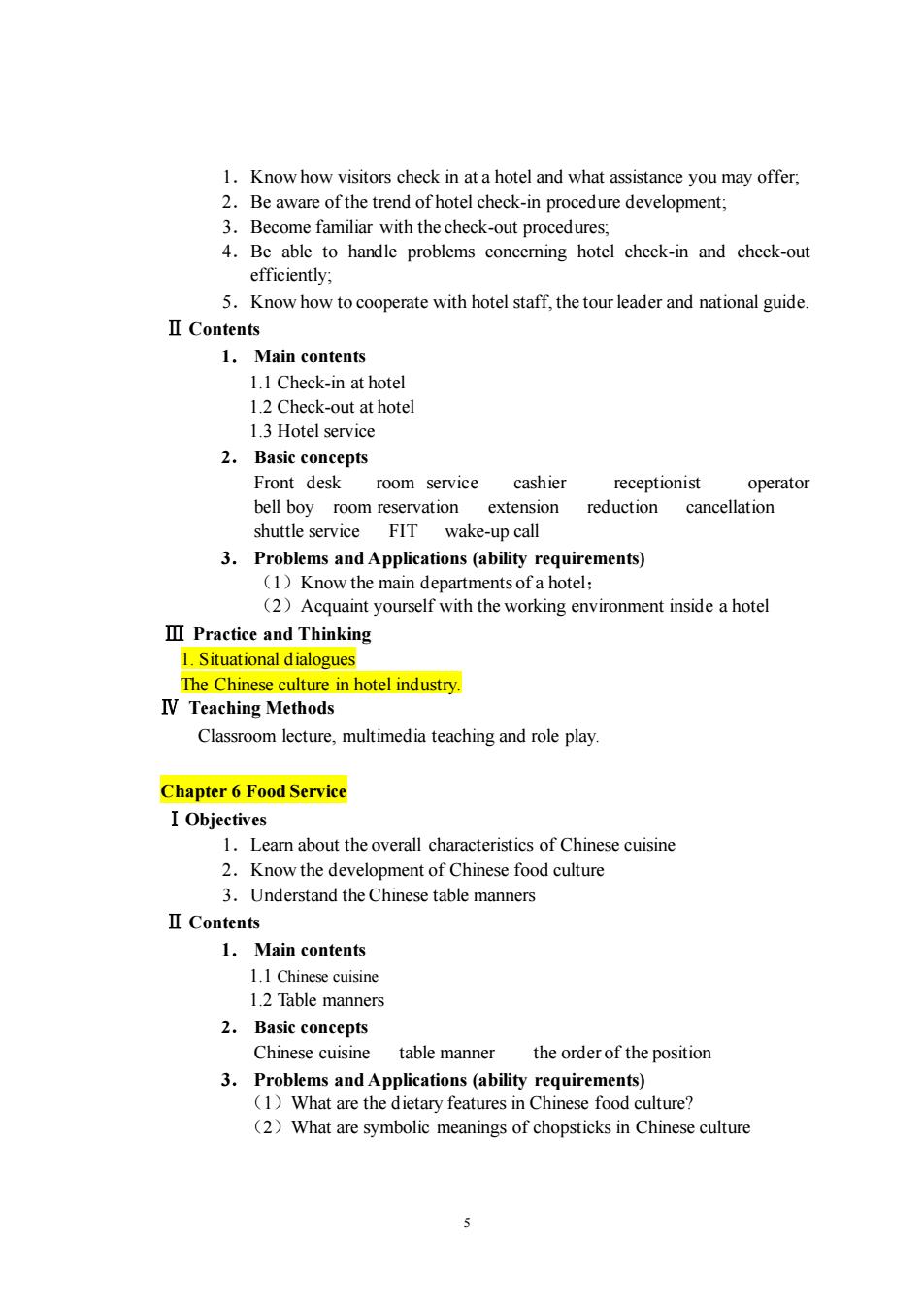
1.Know how visitors check in at a hotel and what assistance you may offer, 2.Be aware of the trend of hotel check-in procedure development; efficiently: 5.Know how to cooperate with hotel staff,the tour leader and national guide II Contents 1.Main contents 1.1Check-in at hotel 1.2 Check -out at hote 1.3 Hotel service 2.Basic concepts Front desk room service cashie receptionist operator bell boy room reservation extension reduction cancellation shuttle service FIT wake-up call (1)Know the main depa ents of (2)Acquaint yourse a hotel ith the working environment inside a hote II Practice and Thinking .Situational dialogues The Chinese culture in hotel industry. IV Teaching Methods Classroom lecture,multimedia teaching and role play Chapter6 Food Service I Objectives 1.Leam about the overall characteristics of Chinese cuisine 2.Know the development of Chinese food culture 3.Understand the Chinese table manners ⅡContents 1.Main contents 1.1 Chinese cuisine 1.2 Table manners 2. Basic concepts Chinese cuisine table manner the order of the position 3.Problems and Applications (ability requirements) ary features in Ch ulture? (2)What are symb ic meanings of chopsticks in Chinese culture 5
5 1.Know how visitors check in at a hotel and what assistance you may offer; 2.Be aware of the trend of hotel check-in procedure development; 3.Become familiar with the check-out procedures; 4.Be able to handle problems concerning hotel check-in and check-out efficiently; 5.Know how to cooperate with hotel staff, the tour leader and national guide. Ⅱ Contents 1. Main contents 1.1 Check-in at hotel 1.2 Check-out at hotel 1.3 Hotel service 2. Basic concepts Front desk room service cashier receptionist operator bell boy room reservation extension reduction cancellation shuttle service FIT wake-up call 3. Problems and Applications (ability requirements) (1)Know the main departments of a hotel; (2)Acquaint yourself with the working environment inside a hotel Ⅲ Practice and Thinking 1. Situational dialogues The Chinese culture in hotel industry. Ⅳ Teaching Methods Classroom lecture, multimedia teaching and role play. Chapter 6 Food Service ⅠObjectives 1.Learn about the overall characteristics of Chinese cuisine 2.Know the development of Chinese food culture 3.Understand the Chinese table manners Ⅱ Contents 1. Main contents 1.1 Chinese cuisine 1.2 Table manners 2. Basic concepts Chinese cuisine table manner the order of the position 3. Problems and Applications (ability requirements) (1)What are the dietary features in Chinese food culture? (2)What are symbolic meanings of chopsticks in Chinese culture

(3)How to deal with different customs in food culture? II Practice and Thinking 1.Picture talk(can be any other local cuisine) Zhejiang Cuisine 2.Talk about the order of the position(for example,which is the most important on the left or the most important on the right?) 3.Meaning of chopstick (Besides the ng mentioned in the video,what othe cultur cepts include th em,suc as:why are tradit opsticks round one end and square at the other?What kind of traditional ideas do two chopsticks represent? IV Teaching Methods Classroom lecture.multimedia teaching and case study Chapter 7Tour Planning I Objectives 1.See the importance of tour planning: 2.Be able to explain the tour planning: 3.Leam how todiscuss itinerary with your guests. 4.Leam the skills of setting tour itinerary ⅡContents 1.Main contents 1.1 Tourist schedule planning principles 1.2 Special preparations needed for special visitors 1.3 Itinerary discussion 2. Basic concepts Tourist schedule planning 3.Problems and Applications(ability requirements) (1)Make clear the following points when making a tour planning: (2)Double check arrangements of some key points: (3)The general procedure of itinerary discussion. and Thinking 1.Situational dialogues 2.Designing travel programs,introduces the specialties and the culture of the 6
6 (3) How to deal with different customs in food culture? Ⅲ Practice and Thinking 1.Picture talk(can be any other local cuisine) 2.Talk about the order of the position (for example, which is the most important on the left or the most important on the right?) 3. Meaning of chopsticks (Besides the meaning mentioned in the video, what other cultural concepts include them, such as: Why are traditional chopsticks round at one end and square at the other? What kind of traditional ideas do two chopsticks represent? Ⅳ Teaching Methods Classroom lecture, multimedia teaching and case study. Chapter 7 Tour Planning ⅠObjectives 1.See the importance of tour planning; 2.Be able to explain the tour planning; 3.Learn how to discuss itinerary with your guests; 4.Learn the skills of setting tour itinerary. Ⅱ Contents 1. Main contents 1.1 Tourist schedule planning principles 1.2 Special preparations needed for special visitors 1.3 Itinerary discussion 2. Basic concepts Tourist schedule planning 3. Problems and Applications (ability requirements) (1)Make clear the following points when making a tour planning; (2)Double check arrangements of some key points; (3)The general procedure of itinerary discussion. Ⅲ Practice and Thinking 1. Situational dialogues 2. Designing travel programs, introduces the specialties and the culture of the

destinations. IV Teaching Methods Classroom lecture,multimedia teaching and role play Chapter 8 Sightseeing I Objectives 1.Leam how to introduce toa tour group on the way toatourist attraction 2.Leamn the skills of making a tour commentary. IIContents 1.Main contents 1.1 Method of introduction 1.2 Skills for guiding during sightseeing 2. Basic concepts sightseeing tempo quotation introduction with a key events tracing analogy between two events question-and-answer introductions introduction of combining facts and fign ents explanatory introduction ng a crucial touch to the picture oduction lead ing someone to a fascinating vista 3.Problems and Applications (ability requirements) (1)Make clear points hen making a tour planning: (2)Double c hec k arrangemen of some k Key points (3)The general procedure of itinerary discussion II Practice and Thinking IV Teaching Methods Classroom lecture,multimedia teaching and role play Chapter9Shopping in China I Objectives 1.To familiarize learners with the traditional Chinese craft and specialties 2.To leam how to provide the shopping service II Contents 1.Main contents 1.1 Chinese tea 1.2 Jade Culture 1.3 Paper cutting
7 destinations. Ⅳ Teaching Methods Classroom lecture, multimedia teaching and role play. Chapter 8 Sightseeing ⅠObjectives 1.Learn how to introduce to a tour group on the way to a tourist attraction; 2.Learn the skills of making a tour commentary. Ⅱ Contents 1. Main contents 1.1 Method of introduction 1.2 Skills for guiding during sightseeing 2. Basic concepts sightseeing tempo quotation introduction with a key events tracing analogy between two events question-and-answer introductions introduction of combining facts and figments explanatory introduction suspense-creating introduction giving a crucial touch to the picture section-by-section introduction descriptive introduction leading someone to a fascinating vista 3. Problems and Applications (ability requirements) (1)Make clear the following points when making a tour planning; (2)Double check arrangements of some key points; (3)The general procedure of itinerary discussion. Ⅲ Practice and Thinking 1. Situational dialogues 2. Draft a commentary of any RED revolution scenic spot place you like. Ⅳ Teaching Methods Classroom lecture, multimedia teaching and role play. Chapter 9 Shopping in China ⅠObjectives 1.To familiarize learners with the traditional Chinese craft and specialties 2.To learn how to provide the shopping service Ⅱ Contents 1. Main contents 1.1 Chinese tea 1.2 Jade Culture 1.3 Paper cutting
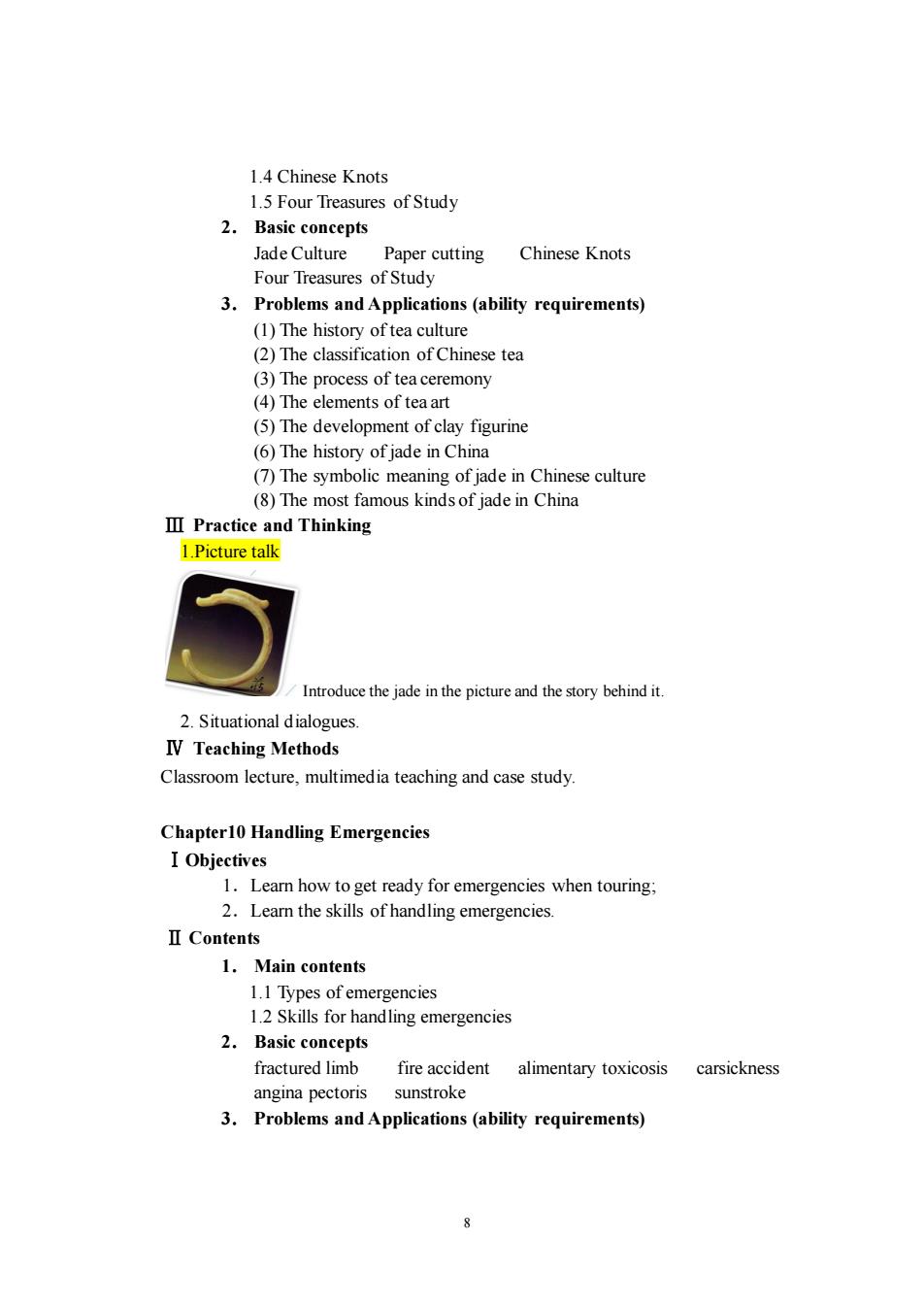
1.4 Chinese Knots 1.5 Four Treasures of Study 2.Basic concepts Jade Culture Paper cutting Chinese Knots Four Treasures of Study 3.Problems and Applications(ability requirements) (1)The history oftea culture (2)The classification of Chinese tea (3)The process of tea ceremony (4)The elements of tea art (5)The development of clay figurine (6)The history ofjade in China (7)The symbolic meaning of jade in Chinese culture (8)The most famous kinds of jade in China III Practice and Thinking Introduce the jade in the picture and the story behind it 2.Situational dialogues. IV Teaching Methods Classroom lecture,multimedia teaching and case study Chapter10 Handling Emergencies I Objectives I.Leamn how to get ready for emergencies when touring: 2.Learn the skills of handling emergencies. II Contents 1.Main contents ergencies 2.Basic concepts fractured limb fire accident alimentary toxicosis carsickness angina pectoris sunstroke 3.Problems and Applications(ability requirements) 8
8 1.4 Chinese Knots 1.5 Four Treasures of Study 2. Basic concepts Jade Culture Paper cutting Chinese Knots Four Treasures of Study 3. Problems and Applications (ability requirements) (1) The history of tea culture (2) The classification of Chinese tea (3) The process of tea ceremony (4) The elements of tea art (5) The development of clay figurine (6) The history of jade in China (7) The symbolic meaning of jade in Chinese culture (8) The most famous kinds of jade in China Ⅲ Practice and Thinking 1.Picture talk Introduce the jade in the picture and the story behind it. 2. Situational dialogues. Ⅳ Teaching Methods Classroom lecture, multimedia teaching and case study. Chapter10 Handling Emergencies ⅠObjectives 1.Learn how to get ready for emergencies when touring; 2.Learn the skills of handling emergencies. Ⅱ Contents 1. Main contents 1.1 Types of emergencies 1.2 Skills for handling emergencies 2. Basic concepts fractured limb fire accident alimentary toxicosis carsickness angina pectoris sunstroke 3. Problems and Applications (ability requirements)

(1)Make clear the main points when facing emergencies: (2)Prepare for theemergencies. II Practice and Thinking I Situational dialogues To show Chinese traditional culture of"YiHe WeiGui"take humorous as the most important treasure. IV Tea aching methods Classroom lecture.multimedia teaching and role play Chapter11 Seeing off Guests and Farewell Speeches I Objectives 1.Leamn how to prepare for seeing off the guests: 2.Know the steps should follow when arranging departure issues, 3.Make a farewell speech II Contents 1.Main contents 1.1The steps should follow when arranging departure issues 2.Basic concepts farewell speech visa passport custom tax declaration 3.Problems and Applications(ability requirements) (1)The steps should follow when arranging departure issues; (2)Main contents of a farewell speech.(to show the traditional sayings of friendship.) II Practice and Thinking 1.Situational dialogues IV Teaching Methods Classroom lecture,multimedia teaching and role play. 五、各教学环节学时分配 教学环 讲 习 讨 共他 敦学时数 论 实验 实习 教学 荣 环带 课程内容 Chapterl
9 (1)Make clear the main points when facing emergencies; (2)Prepare for the emergencies. Ⅲ Practice and Thinking 1. Situational dialogues To show Chinese traditional culture of “Yi He Wei Gui”, take humorous as the most important treasure. Ⅳ Teaching Methods Classroom lecture, multimedia teaching and role play. Chapter11 Seeing off Guests and Farewell Speeches ⅠObjectives 1.Learn how to prepare for seeing off the guests; 2.Know the steps should follow when arranging departure issues; 3.Make a farewell speech. Ⅱ Contents 1. Main contents 1.1 The steps should follow when arranging departure issues 1.2 Make a farewell speech 2. Basic concepts farewell speech visa passport custom tax declaration 3. Problems and Applications (ability requirements) (1)The steps should follow when arranging departure issues; (2)Main contents of a farewell speech.(to show the traditional sayings of friendship.) Ⅲ Practice and Thinking 1. Situational dialogues Ⅳ Teaching Methods Classroom lecture, multimedia teaching and role play. 五、各教学环节学时分配 教学环 节 教学时数 课程内容 讲 课 习 题 课 讨 论 课 实验 实习 其他 教学 环节 小 计 Chapter1 1 1 2

Chapter2 Chapter3 Chapter4 Chapter5 Chapter6 Chapter7 Chapter8 4 Chapter9 Chapter10 Chapterll 合计 1 21 32 “各教学环节学时分配”中,“其它教学环节”主要指习题课、课堂讨论、课程设计、观看视 频、现场参观等教学环节。 六、课程考核 (一)考核方式考查 (二)成绩构成 平时成绩占比:60% 期末考试占比:40% (三)成绩考核标准 1.考核选题方向可为独立撰写一篇英文导游词并进行现场演示:或以小组为单位, 以某一旅游服务工作场景为基础撰写情景对话,并进行现场演示: 2.导游词写作要求语法正确、用语规范:符合导游词写作基本要素要求;适当使用 导游讲解方法与技巧: 3.情景对话撰写要求场景完整合理:对话双方内容相当,没有任何一方内容明显较 多:语法正确、用语规范: 3.现场演示要求口语表达流利、发音准确: 4.现场演示如为导游讲解则要求能够运用导游现场讲解基本方法与技巧: 5.导游词写作及对话编写内容要符合社会主义核心价值观,体现对祖国、家乡的热 爱之情,对民族文化、传统文化的自信。 10
10 Chapter2 1 1 2 Chapter3 1 1 2 Chapter4 1 2 3 Chapter5 1 2 3 Chapter6 1 2 3 Chapter7 1 3 4 Chapter8 1 3 4 Chapter9 1 3 4 Chapter10 1 2 3 Chapter11 1 1 2 合计 11 21 32 “各教学环节学时分配”中,“其它教学环节”主要指习题课、课堂讨论、课程设计、观看视 频、现场参观等教学环节。 六、课程考核 (一)考核方式 考查 (二)成绩构成 平时成绩占比:60% 期末考试占比:40% (三)成绩考核标准 1.考核选题方向可为独立撰写一篇英文导游词并进行现场演示;或以小组为单位, 以某一旅游服务工作场景为基础撰写情景对话,并进行现场演示; 2.导游词写作要求语法正确、用语规范;符合导游词写作基本要素要求;适当使用 导游讲解方法与技巧; 3.情景对话撰写要求场景完整合理;对话双方内容相当,没有任何一方内容明显较 多;语法正确、用语规范; 3.现场演示要求口语表达流利、发音准确; 4.现场演示如为导游讲解则要求能够运用导游现场讲解基本方法与技巧; 5.导游词写作及对话编写内容要符合社会主义核心价值观,体现对祖国、家乡的热 爱之情,对民族文化、传统文化的自信